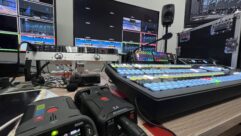
World-changing Event, Part 2
Jun 26, 2008 11:24 AM,
By John W. DeWitt

For the World Changing Ideas ceremony, PeopleTech Events constructed a 7’x7′ front-projected video cube and hung it from a truss grid built especially for the event held Feb. 21 in Saatchi & Saatchi’s Manhattan headquarters.
Staging a world-changing event requires careful planning and seamless execution. Nashville, Tenn.-based PeopleTech Events began to prepare in earnest more than three months prior to the World Changing Ideas Awards ceremony in Saatchi & Saatchi’s Manhattan headquarters. The global marketing firm’s 50’x96’ White Room provided the challenging venue for its Feb. 21 gala recognizing the 2007/2008 award winner, Vestergaard Frandsen of Switzerland and his LifeStraw portable water purifier, along with breakthrough innovators and innovations. Bob Isherwood, Saatchi’s worldwide creative director and the convener of the award, wanted an event as distinctive as its honorees and attendees. “This year, there was a desire to take it up a notch, with a strong focus on the presentation ceremony itself, the finalists, and their unique contributions,” explains Chris Simmons, PeopleTech’s project manager and creative director.
The creative planning process began with a PowerPoint slide presentation of ideas and photos sent by Saatchi. Then came Simmons’ site visit. “Our lighting designer, Ryan Turzanski, went with me and we laser measured every niche and corner, got the ceiling heights and everything else right,” Simmons says. “We also found out there were power restrictions in the room, which is on first floor of a skyscraper.”
As noted in Part 1 of this story, PeopleTech designed a truss grid to compensate for the White Room’s lack of rigging, and then put the trusses to creative use for a variety of lighting, audio, video, and visual purposes. “The horizontal truss was 14ft. in the air and had eight truss legs,” Simmons says. “We hung all the lights, sound, and video projectors off the horizontal truss structure, and the legs themselves were lit to warm them up.
“From that truss we hung 1ft.-square, 7ft.-long boxes as vertical lanterns over the display tables for each of the award winners,” he says. “We took frosted plex and, using a CNC router, etched the letters for the name of each winning idea, so that when we put in the light source, the letters glowed, the whole structure glowed, and because it was open at the bottom, the light source hit the Formica display table that was below it.” Those laminated white-gloss display tables were bar height, 42in. tall, with a 30in.-square light box for a top and included a power access panel for displays that use laptops.
Perhaps the most innovative AV element hung from the truss grid was a video cube.
“We wanted it internally projected, but couldn’t use LED panels, so we ended up creating an aluminum framework 7’x7’ cube with front-projected material on the sides,” Simmons says. “We had all the video created to a square format and projected on each side of the cube. The bottom portion of the cube—the fifth side—you could walk under. Originally, we were going to project video on that side too, but instead, we created a glowing ceiling were we could project changing colors.”
The small stage got creative visual treatment too.
“[Saatchi] wanted the stage to look cool, so I actually took leftover lantern material, the frosted plex, wrapped it around the façade of the stage, and put in LED lights, so the front of the stage glowed, giving it a mod, high-tech feel,” Simmons says.
PeopleTech’s audio engineer, Michael Corbett, took equal care with staging and operating the Meyer Sound system brought in especially for the event.
“Mike had to blend the sound where you didn’t have dead areas and it did not overwhelm the conversation in the room, yet when someone went up to the stage to speak, you could hear it,” Simmons says. “But the biggest challenge for Mike was having to put our tech area in the back catering area with no sight line to the room. During the event our technical director, Trent LeClaire, was out on the floor, calling back-of-stage on ClearComm, to make the adjustments.” Meanwhile, Trent’s twin brother, PeopleTech video engineer Tim LeClaire, managed the video cube.
“Basically, everything went smoothly,” Simmons says, noting that his four-person crew had plentiful time for advance setup and post-event breakdown. “We had about two to three days load-in, and it was a self-contained facility where we didn’t have to be in and out over the course of the night, so that gave us some flexibility. Also, what was really cool, after the Thursday night event, they opened up the room for breakfast Friday morning for the Satchi folks who didn’t attend the ceremony.”
PeopleTech’s client was pleased with the outcome of this year’s World Changing Ideas ceremony.
“The Saatchi folks said we raised the bar from what they had done in the past. They felt it was one of the best productions they have done,” Simmons says. “And of course, the ideas that were presented by these contestants were phenomenal.”
For more information, visit www.peopletechevents.com and www.saatchi.com.










